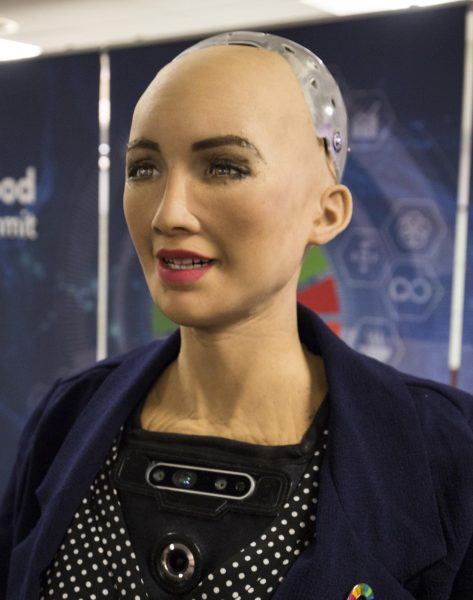Tesla turns trucks cyber
Tesla’s new electric truck opens new door for vehicular innovation
“Trucks have been the same for a very long time… we want to try something different.” As CEO of Tesla Elon Musk said in the November presentation of Tesla’s new truck, Cybertruck is certainly something different.
Tesla and Musk have been hinting at releasing a truck for many years since 2012. And as Tesla’s enthusiast’s dreams finally came true with this release of what Tesla calls the “Cybertruck”, it wasn’t quite what anyone was expecting. When the truck first rolled onto the stage, the audience and viewers of the livestream were all caught off guard by the planar shape of the truck.
Its physical appearance features a very geometric design with an overall large body. Cybertruck comes in 3 variants: single motor RWD, dual motor AWD, and tri motor AWD, all $39,900, $49,900, and $69,900 respectively. It’s equipped with standard autopilot capability on all variants and the option to have full self driving. The truck is about 19.3 feet in length, 6.6 feet wide, 6.25 feet tall, with a 6.5 foot bed. One of the trucks most appealing features is the adaptive air suspension, which can adjust for maximum efficiency on any terrain.
Moments before the end of the presentation, Musk also surprised the audience by giving a brief glance at their “Cyber Quad” ATV, which they loaded into the back of the prototype Cybertruck. The ATV is, of course, all electric with a similar design to the Cybertruck. However, no further details have been given about the ATV thus far.
The design of the truck is inspired by the 1982 film “Blade Runner”, which takes place in a dystopian cyberistic future. It’s no surprise Musk decided to announce the Cybertruck in November of 2019, the same date the film takes place. However, the truck isn’t set to release until late 2021, but preorders are currently being accepted with a $100 confirmation deposit.
Musk explained in a tweet a few days after the presentation the reasoning for Cybertruck’s geometric shape: “Reason Cybertruck is so planar is that you can’t stamp ultra-hard 30x steel because it breaks the stamping press.” He continued with, “Even bending it requires a deep score on inside of bend, which is how the prototype was made.”
Because of the truck’s odd design and overall presentation, it quickly blew up in the media and led many to believe this to be a total joke from Tesla. But as Musk has emphasized, one of the goals of Cybertruck is to go against the status quo of trucks, which might be the reason so many think Cybertruck isn’t something actually viable to use. But surprisingly, the Cybertruck is actually much more competent than most gas-powered trucks on the market today.
Musk demonstrated the power of Cybertruck through many demonstrations throughout the presentation. He first showed a “tug of war” contest between the Cybertruck and Ford’s flagship F-150, in which the Cybertruck easily overpowered the F-150 on an uphill slope. Soon after, Musk demonstrated the on road performance of 0-60 in 2.9 seconds against a brand new Porsche 911, with the Cybertruck prevailing with a landslide victory once again.
Still, the reactions of potential consumers are mixed. “It [Cybertruck] beats the Ford F-150 in an uphill tow race, it’s faster from 0-60, heavier yet higher top speed, it’s cheap with only a 100 dollar down payment, and it looks like it was drawn by a kindergartener,” Tyler Torres (12) said.
“I don’t like it. It seems like it’s going to have a lot of issues because of the new technology” Gage Andersen (11) said.
Beyond performance, the Cybertruck is made of an Ultra-Hard 30x Cold-Rolled stainless-steel exoskeleton. This makes it immune to dents, and even bulletproof, as Musk once again demonstrated by slamming the truck with a sledgehammer, and making bullets look like paintballs. But while all of Musk’s impressive demonstrations astounded the audience, there was one that didn’t quite go as planned.
Musk introduced the Tesla Armor Glass equipped on the Cybertruck, made of transparent metal, and followed up with a demonstration of dropping a solid metal ball from several heights. But to flaunt the power of the glass more, Musk had his chief designer, Franz von Holzhuasen, throw the metal ball directly at the window. And unexpectedly, the window shattered but did not penetrate. Elon responded with surprised profanity then followed with “little room for improvement.” Musk later tweeted, “Sledgehammer impact on door cracked base of glass, which is why steel ball didn’t bounce off. Should have done steel ball on window, *then* sledgehammer the door. Next time…” He also proved this by tweeting a video of Holzhuasen throwing the metal ball at the window just moments before the presentation.
Andersen, in particular, was impacted by the failed glass demo in November’s presentation: “If they can get it right, then I think it would be a great idea because there are a lot of places in the world that could use stuff like that. But until they get it right, I don’t think they should announce they have bulletproof glass.”
The window demonstration led many critics to be skeptical of the Cybertruck’s actual viability, but it didn’t stop the over 250 thousand orders only 5 days after the reveal of Cybertruck. Future owners ordered not only for the features Cybertruck has to offer, but the implications it might have in the future. Cybertruck is likely to make a major impact on the vehicle industry as Tesla’s other vehicles already have. It proves that electric vehicles are just as (if not more) powerful, affordable, and efficient as any other fossil fuel powered vehicle. “I think it’s going to be the new edge and future of trucks,” Cody Reynolds (10) said. But the implication goes beyond just the truck industry. The introduction of electric vehicles (especially considering trucks are the top 3 number one selling vehicles in America) opens up the window of change for the economy and even more importantly the environment. It’s been tested and true that fossil fuels are creating more carbon dioxide in our atmosphere than ever before. Getting rid of one of the largest contributors to fossil fuels would greatly reduce our carbon footprint and could inspire change in all other areas of the world’s economy and society.
The Tesla Cybertruck may not be the typical truck we’re used to, but it certainly could be the truck we need.

Born December 22, 2001
Snowboarder, pianist (kinda), aspiring mechanical engineer
Berserker Class







